Alpha-Mannosidosis: A Comprehensive Report on the Genetic Disorder
VerifiedAdded on 2022/11/30
|9
|2142
|174
Report
AI Summary
This report provides a comprehensive overview of Alpha-Mannosidosis, a rare recessive genetic disorder resulting from a deficiency in lysosomal alpha-mannosidase. It begins with an introduction to the disease, including its characteristics, causes, and prevalence. The research section delves into the latest scientific articles and advancements related to the disorder, focusing on the MAN2B1 gene and its role in the production of the alpha-mannosidase enzyme. The diagnosis section outlines the diagnostic methods, including clinical evaluations, laboratory tests, and molecular genetic testing. The treatment section discusses the current treatment options, including enzyme replacement therapy and supportive care. Finally, the report addresses policy considerations, such as early intervention, genetic counseling, and the importance of proactive management to improve the quality of life for individuals affected by Alpha-Mannosidosis. The report incorporates information from recent scientific articles and provides a well-rounded understanding of the disease, its management, and related policies.
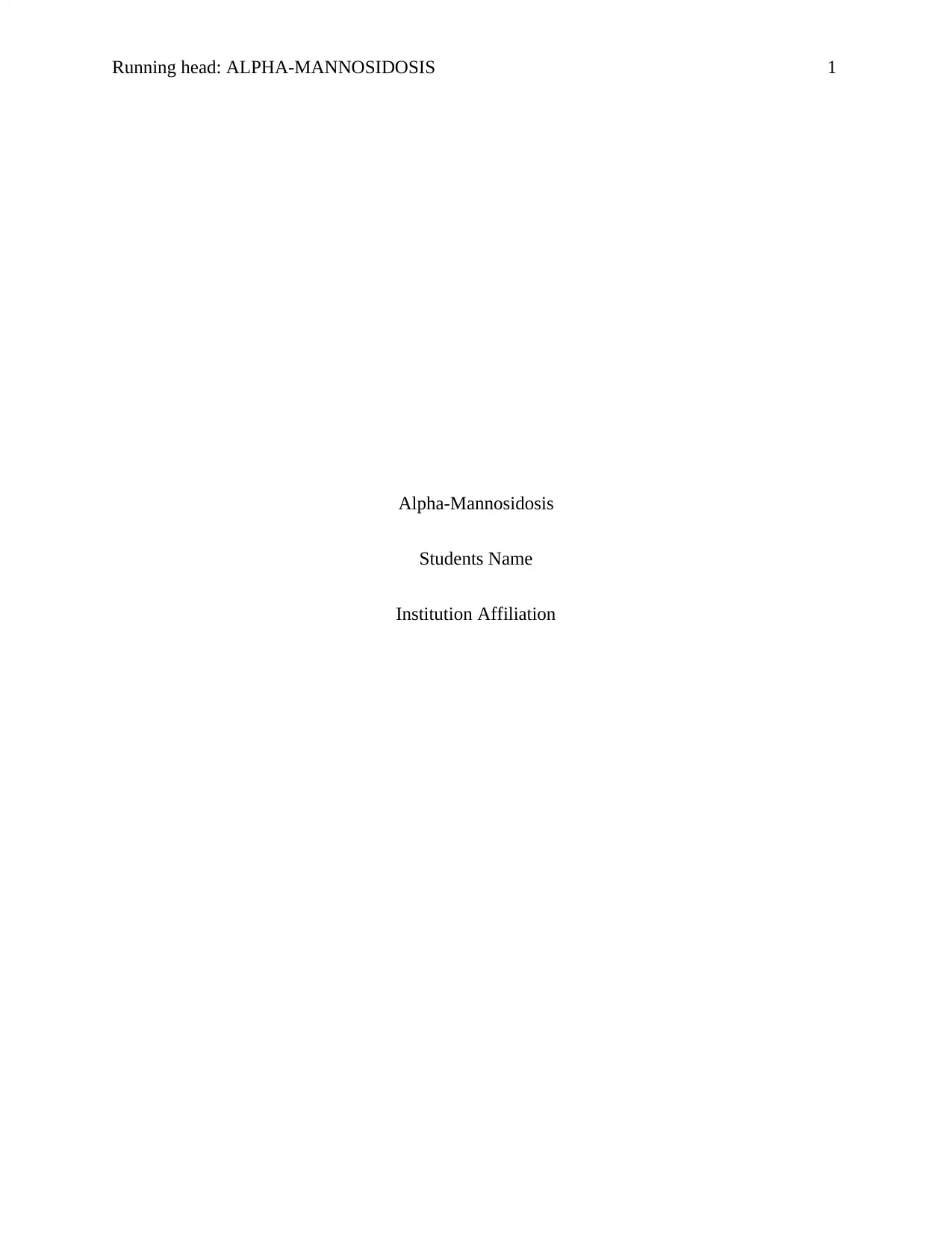
Running head: ALPHA-MANNOSIDOSIS 1
Alpha-Mannosidosis
Students Name
Institution Affiliation
Alpha-Mannosidosis
Students Name
Institution Affiliation
Paraphrase This Document
Need a fresh take? Get an instant paraphrase of this document with our AI Paraphraser
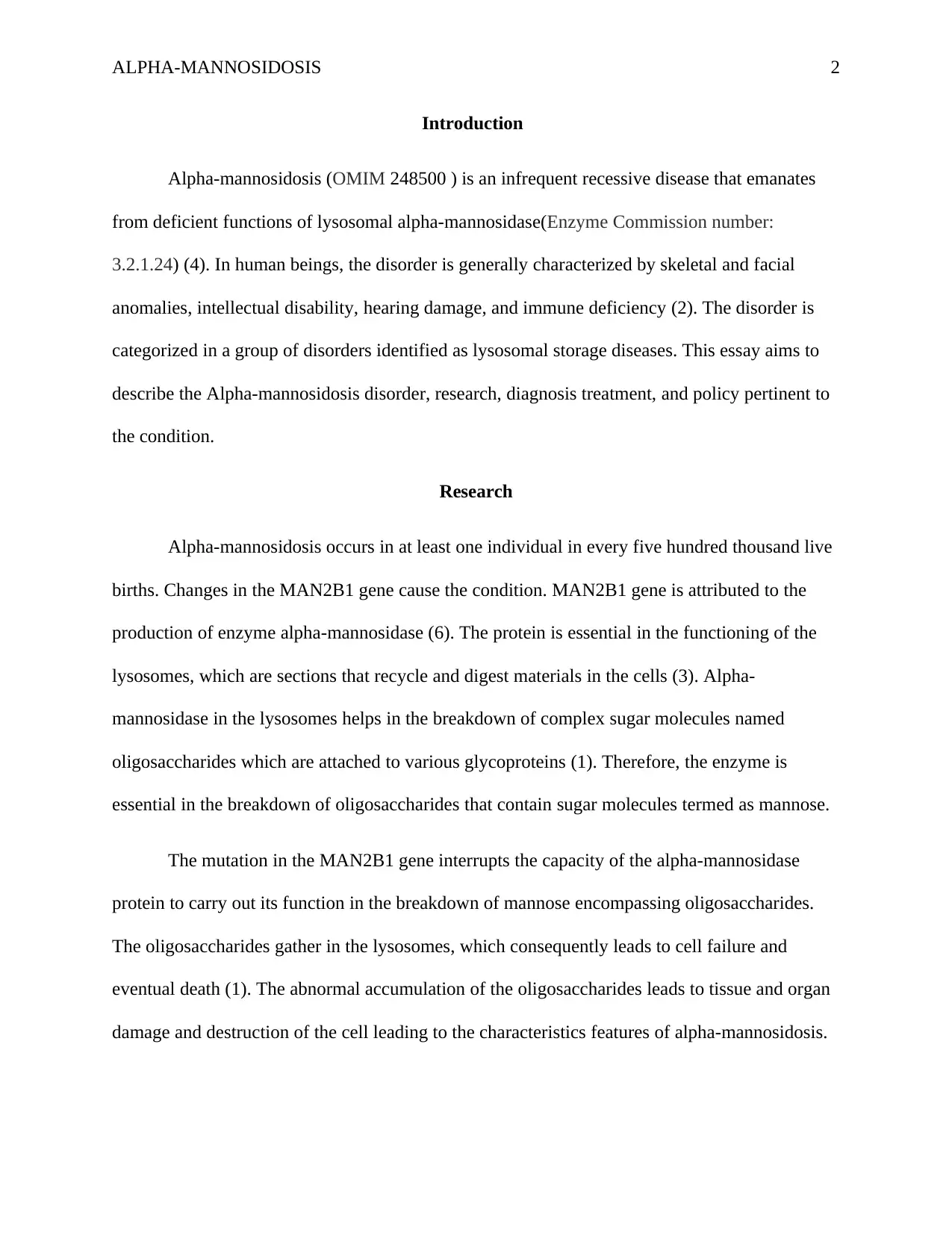
ALPHA-MANNOSIDOSIS 2
Introduction
Alpha-mannosidosis (OMIM 248500 ) is an infrequent recessive disease that emanates
from deficient functions of lysosomal alpha-mannosidase(Enzyme Commission number:
3.2.1.24) (4). In human beings, the disorder is generally characterized by skeletal and facial
anomalies, intellectual disability, hearing damage, and immune deficiency (2). The disorder is
categorized in a group of disorders identified as lysosomal storage diseases. This essay aims to
describe the Alpha-mannosidosis disorder, research, diagnosis treatment, and policy pertinent to
the condition.
Research
Alpha-mannosidosis occurs in at least one individual in every five hundred thousand live
births. Changes in the MAN2B1 gene cause the condition. MAN2B1 gene is attributed to the
production of enzyme alpha-mannosidase (6). The protein is essential in the functioning of the
lysosomes, which are sections that recycle and digest materials in the cells (3). Alpha-
mannosidase in the lysosomes helps in the breakdown of complex sugar molecules named
oligosaccharides which are attached to various glycoproteins (1). Therefore, the enzyme is
essential in the breakdown of oligosaccharides that contain sugar molecules termed as mannose.
The mutation in the MAN2B1 gene interrupts the capacity of the alpha-mannosidase
protein to carry out its function in the breakdown of mannose encompassing oligosaccharides.
The oligosaccharides gather in the lysosomes, which consequently leads to cell failure and
eventual death (1). The abnormal accumulation of the oligosaccharides leads to tissue and organ
damage and destruction of the cell leading to the characteristics features of alpha-mannosidosis.
Introduction
Alpha-mannosidosis (OMIM 248500 ) is an infrequent recessive disease that emanates
from deficient functions of lysosomal alpha-mannosidase(Enzyme Commission number:
3.2.1.24) (4). In human beings, the disorder is generally characterized by skeletal and facial
anomalies, intellectual disability, hearing damage, and immune deficiency (2). The disorder is
categorized in a group of disorders identified as lysosomal storage diseases. This essay aims to
describe the Alpha-mannosidosis disorder, research, diagnosis treatment, and policy pertinent to
the condition.
Research
Alpha-mannosidosis occurs in at least one individual in every five hundred thousand live
births. Changes in the MAN2B1 gene cause the condition. MAN2B1 gene is attributed to the
production of enzyme alpha-mannosidase (6). The protein is essential in the functioning of the
lysosomes, which are sections that recycle and digest materials in the cells (3). Alpha-
mannosidase in the lysosomes helps in the breakdown of complex sugar molecules named
oligosaccharides which are attached to various glycoproteins (1). Therefore, the enzyme is
essential in the breakdown of oligosaccharides that contain sugar molecules termed as mannose.
The mutation in the MAN2B1 gene interrupts the capacity of the alpha-mannosidase
protein to carry out its function in the breakdown of mannose encompassing oligosaccharides.
The oligosaccharides gather in the lysosomes, which consequently leads to cell failure and
eventual death (1). The abnormal accumulation of the oligosaccharides leads to tissue and organ
damage and destruction of the cell leading to the characteristics features of alpha-mannosidosis.
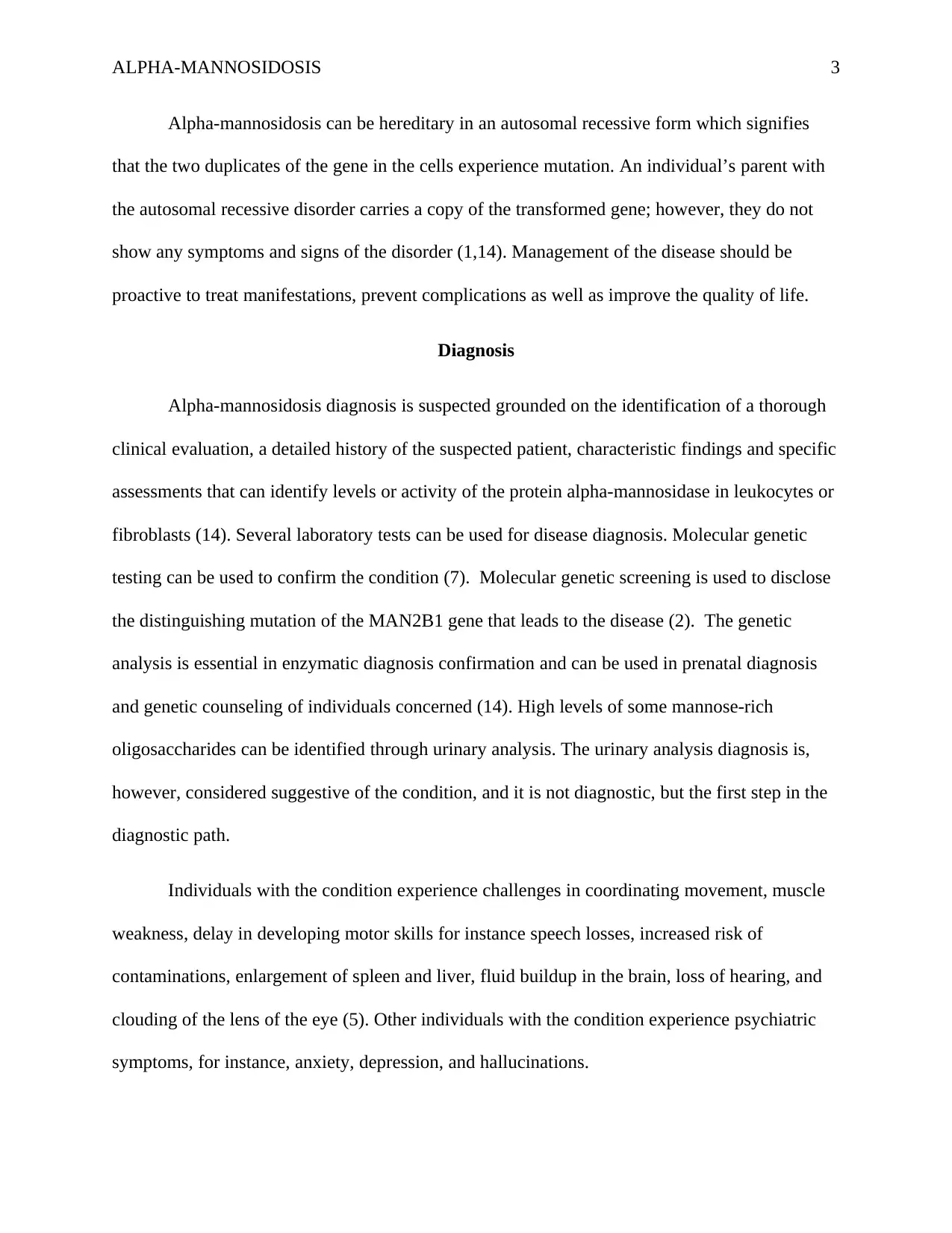
ALPHA-MANNOSIDOSIS 3
Alpha-mannosidosis can be hereditary in an autosomal recessive form which signifies
that the two duplicates of the gene in the cells experience mutation. An individual’s parent with
the autosomal recessive disorder carries a copy of the transformed gene; however, they do not
show any symptoms and signs of the disorder (1,14). Management of the disease should be
proactive to treat manifestations, prevent complications as well as improve the quality of life.
Diagnosis
Alpha-mannosidosis diagnosis is suspected grounded on the identification of a thorough
clinical evaluation, a detailed history of the suspected patient, characteristic findings and specific
assessments that can identify levels or activity of the protein alpha-mannosidase in leukocytes or
fibroblasts (14). Several laboratory tests can be used for disease diagnosis. Molecular genetic
testing can be used to confirm the condition (7). Molecular genetic screening is used to disclose
the distinguishing mutation of the MAN2B1 gene that leads to the disease (2). The genetic
analysis is essential in enzymatic diagnosis confirmation and can be used in prenatal diagnosis
and genetic counseling of individuals concerned (14). High levels of some mannose-rich
oligosaccharides can be identified through urinary analysis. The urinary analysis diagnosis is,
however, considered suggestive of the condition, and it is not diagnostic, but the first step in the
diagnostic path.
Individuals with the condition experience challenges in coordinating movement, muscle
weakness, delay in developing motor skills for instance speech losses, increased risk of
contaminations, enlargement of spleen and liver, fluid buildup in the brain, loss of hearing, and
clouding of the lens of the eye (5). Other individuals with the condition experience psychiatric
symptoms, for instance, anxiety, depression, and hallucinations.
Alpha-mannosidosis can be hereditary in an autosomal recessive form which signifies
that the two duplicates of the gene in the cells experience mutation. An individual’s parent with
the autosomal recessive disorder carries a copy of the transformed gene; however, they do not
show any symptoms and signs of the disorder (1,14). Management of the disease should be
proactive to treat manifestations, prevent complications as well as improve the quality of life.
Diagnosis
Alpha-mannosidosis diagnosis is suspected grounded on the identification of a thorough
clinical evaluation, a detailed history of the suspected patient, characteristic findings and specific
assessments that can identify levels or activity of the protein alpha-mannosidase in leukocytes or
fibroblasts (14). Several laboratory tests can be used for disease diagnosis. Molecular genetic
testing can be used to confirm the condition (7). Molecular genetic screening is used to disclose
the distinguishing mutation of the MAN2B1 gene that leads to the disease (2). The genetic
analysis is essential in enzymatic diagnosis confirmation and can be used in prenatal diagnosis
and genetic counseling of individuals concerned (14). High levels of some mannose-rich
oligosaccharides can be identified through urinary analysis. The urinary analysis diagnosis is,
however, considered suggestive of the condition, and it is not diagnostic, but the first step in the
diagnostic path.
Individuals with the condition experience challenges in coordinating movement, muscle
weakness, delay in developing motor skills for instance speech losses, increased risk of
contaminations, enlargement of spleen and liver, fluid buildup in the brain, loss of hearing, and
clouding of the lens of the eye (5). Other individuals with the condition experience psychiatric
symptoms, for instance, anxiety, depression, and hallucinations.
⊘ This is a preview!⊘
Do you want full access?
Subscribe today to unlock all pages.

Trusted by 1+ million students worldwide
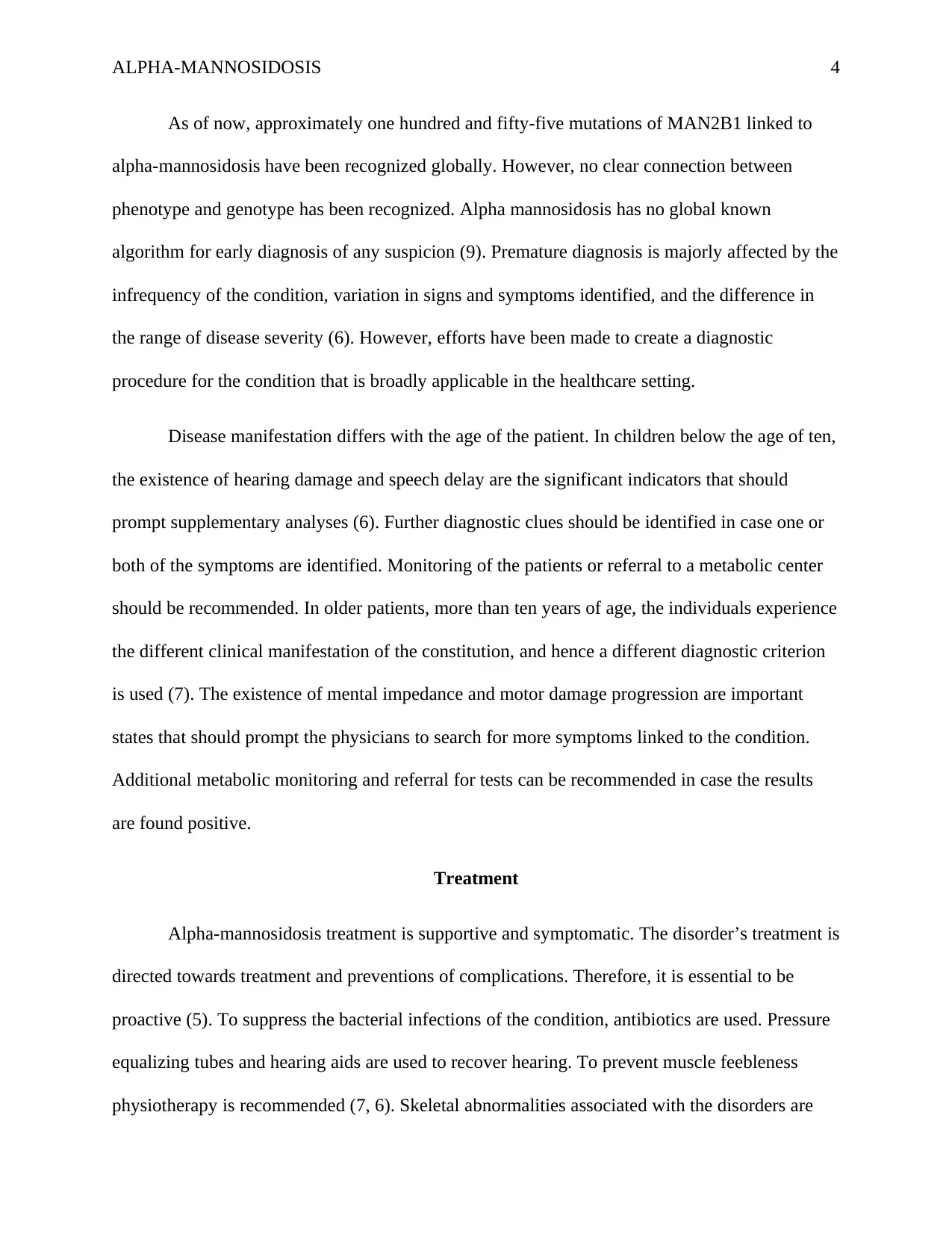
ALPHA-MANNOSIDOSIS 4
As of now, approximately one hundred and fifty-five mutations of MAN2B1 linked to
alpha-mannosidosis have been recognized globally. However, no clear connection between
phenotype and genotype has been recognized. Alpha mannosidosis has no global known
algorithm for early diagnosis of any suspicion (9). Premature diagnosis is majorly affected by the
infrequency of the condition, variation in signs and symptoms identified, and the difference in
the range of disease severity (6). However, efforts have been made to create a diagnostic
procedure for the condition that is broadly applicable in the healthcare setting.
Disease manifestation differs with the age of the patient. In children below the age of ten,
the existence of hearing damage and speech delay are the significant indicators that should
prompt supplementary analyses (6). Further diagnostic clues should be identified in case one or
both of the symptoms are identified. Monitoring of the patients or referral to a metabolic center
should be recommended. In older patients, more than ten years of age, the individuals experience
the different clinical manifestation of the constitution, and hence a different diagnostic criterion
is used (7). The existence of mental impedance and motor damage progression are important
states that should prompt the physicians to search for more symptoms linked to the condition.
Additional metabolic monitoring and referral for tests can be recommended in case the results
are found positive.
Treatment
Alpha-mannosidosis treatment is supportive and symptomatic. The disorder’s treatment is
directed towards treatment and preventions of complications. Therefore, it is essential to be
proactive (5). To suppress the bacterial infections of the condition, antibiotics are used. Pressure
equalizing tubes and hearing aids are used to recover hearing. To prevent muscle feebleness
physiotherapy is recommended (7, 6). Skeletal abnormalities associated with the disorders are
As of now, approximately one hundred and fifty-five mutations of MAN2B1 linked to
alpha-mannosidosis have been recognized globally. However, no clear connection between
phenotype and genotype has been recognized. Alpha mannosidosis has no global known
algorithm for early diagnosis of any suspicion (9). Premature diagnosis is majorly affected by the
infrequency of the condition, variation in signs and symptoms identified, and the difference in
the range of disease severity (6). However, efforts have been made to create a diagnostic
procedure for the condition that is broadly applicable in the healthcare setting.
Disease manifestation differs with the age of the patient. In children below the age of ten,
the existence of hearing damage and speech delay are the significant indicators that should
prompt supplementary analyses (6). Further diagnostic clues should be identified in case one or
both of the symptoms are identified. Monitoring of the patients or referral to a metabolic center
should be recommended. In older patients, more than ten years of age, the individuals experience
the different clinical manifestation of the constitution, and hence a different diagnostic criterion
is used (7). The existence of mental impedance and motor damage progression are important
states that should prompt the physicians to search for more symptoms linked to the condition.
Additional metabolic monitoring and referral for tests can be recommended in case the results
are found positive.
Treatment
Alpha-mannosidosis treatment is supportive and symptomatic. The disorder’s treatment is
directed towards treatment and preventions of complications. Therefore, it is essential to be
proactive (5). To suppress the bacterial infections of the condition, antibiotics are used. Pressure
equalizing tubes and hearing aids are used to recover hearing. To prevent muscle feebleness
physiotherapy is recommended (7, 6). Skeletal abnormalities associated with the disorders are
Paraphrase This Document
Need a fresh take? Get an instant paraphrase of this document with our AI Paraphraser
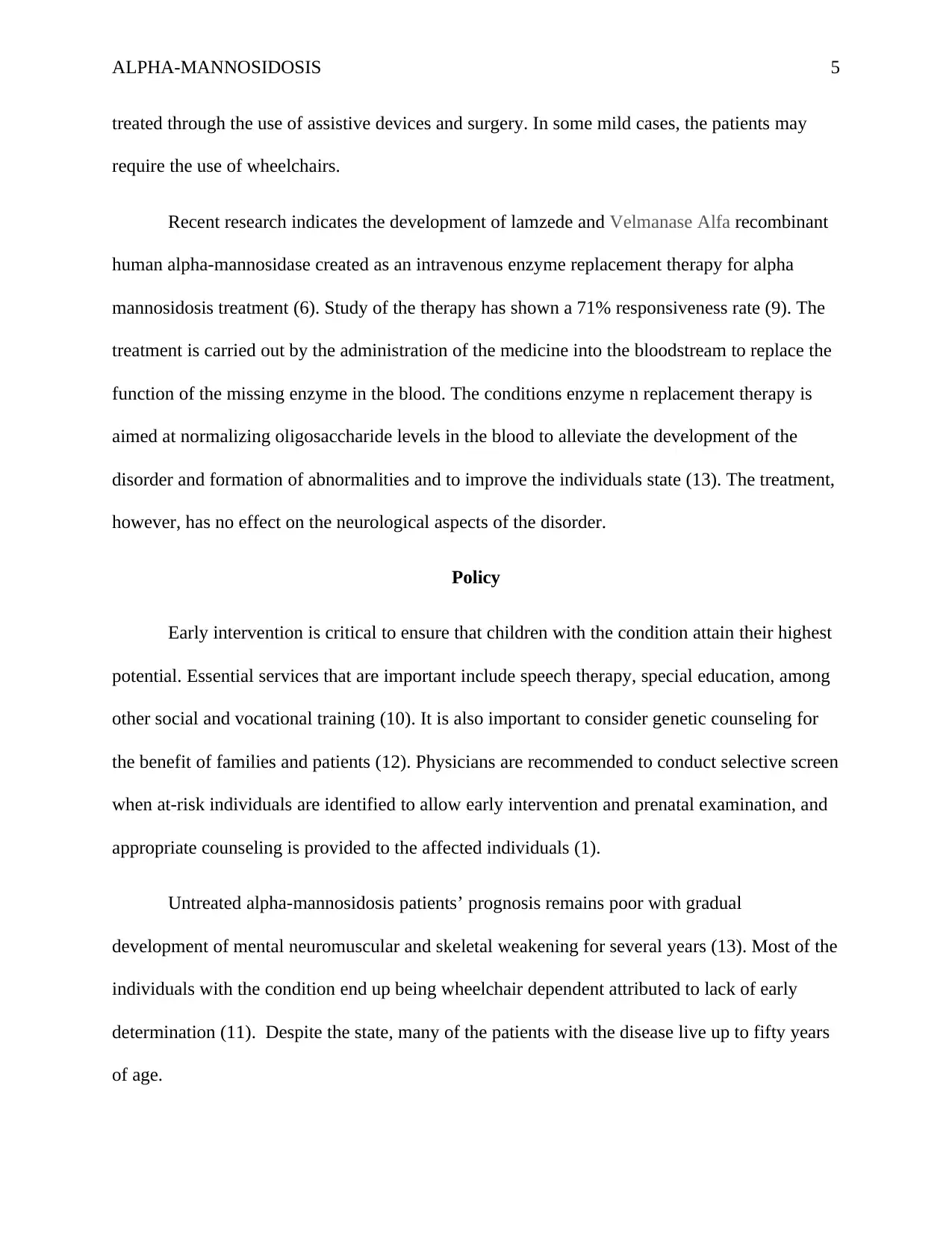
ALPHA-MANNOSIDOSIS 5
treated through the use of assistive devices and surgery. In some mild cases, the patients may
require the use of wheelchairs.
Recent research indicates the development of lamzede and Velmanase Alfa recombinant
human alpha-mannosidase created as an intravenous enzyme replacement therapy for alpha
mannosidosis treatment (6). Study of the therapy has shown a 71% responsiveness rate (9). The
treatment is carried out by the administration of the medicine into the bloodstream to replace the
function of the missing enzyme in the blood. The conditions enzyme n replacement therapy is
aimed at normalizing oligosaccharide levels in the blood to alleviate the development of the
disorder and formation of abnormalities and to improve the individuals state (13). The treatment,
however, has no effect on the neurological aspects of the disorder.
Policy
Early intervention is critical to ensure that children with the condition attain their highest
potential. Essential services that are important include speech therapy, special education, among
other social and vocational training (10). It is also important to consider genetic counseling for
the benefit of families and patients (12). Physicians are recommended to conduct selective screen
when at-risk individuals are identified to allow early intervention and prenatal examination, and
appropriate counseling is provided to the affected individuals (1).
Untreated alpha-mannosidosis patients’ prognosis remains poor with gradual
development of mental neuromuscular and skeletal weakening for several years (13). Most of the
individuals with the condition end up being wheelchair dependent attributed to lack of early
determination (11). Despite the state, many of the patients with the disease live up to fifty years
of age.
treated through the use of assistive devices and surgery. In some mild cases, the patients may
require the use of wheelchairs.
Recent research indicates the development of lamzede and Velmanase Alfa recombinant
human alpha-mannosidase created as an intravenous enzyme replacement therapy for alpha
mannosidosis treatment (6). Study of the therapy has shown a 71% responsiveness rate (9). The
treatment is carried out by the administration of the medicine into the bloodstream to replace the
function of the missing enzyme in the blood. The conditions enzyme n replacement therapy is
aimed at normalizing oligosaccharide levels in the blood to alleviate the development of the
disorder and formation of abnormalities and to improve the individuals state (13). The treatment,
however, has no effect on the neurological aspects of the disorder.
Policy
Early intervention is critical to ensure that children with the condition attain their highest
potential. Essential services that are important include speech therapy, special education, among
other social and vocational training (10). It is also important to consider genetic counseling for
the benefit of families and patients (12). Physicians are recommended to conduct selective screen
when at-risk individuals are identified to allow early intervention and prenatal examination, and
appropriate counseling is provided to the affected individuals (1).
Untreated alpha-mannosidosis patients’ prognosis remains poor with gradual
development of mental neuromuscular and skeletal weakening for several years (13). Most of the
individuals with the condition end up being wheelchair dependent attributed to lack of early
determination (11). Despite the state, many of the patients with the disease live up to fifty years
of age.

ALPHA-MANNOSIDOSIS 6
Conclusion
To conclude, alpha mannosidosis indicates heterogeneity in its treatment and impact on
the patients and families. Early determination and access to therapy provide a high chance of
reducing the disorder development and may offer some relief to patients and their families.
Conclusion
To conclude, alpha mannosidosis indicates heterogeneity in its treatment and impact on
the patients and families. Early determination and access to therapy provide a high chance of
reducing the disorder development and may offer some relief to patients and their families.
⊘ This is a preview!⊘
Do you want full access?
Subscribe today to unlock all pages.

Trusted by 1+ million students worldwide
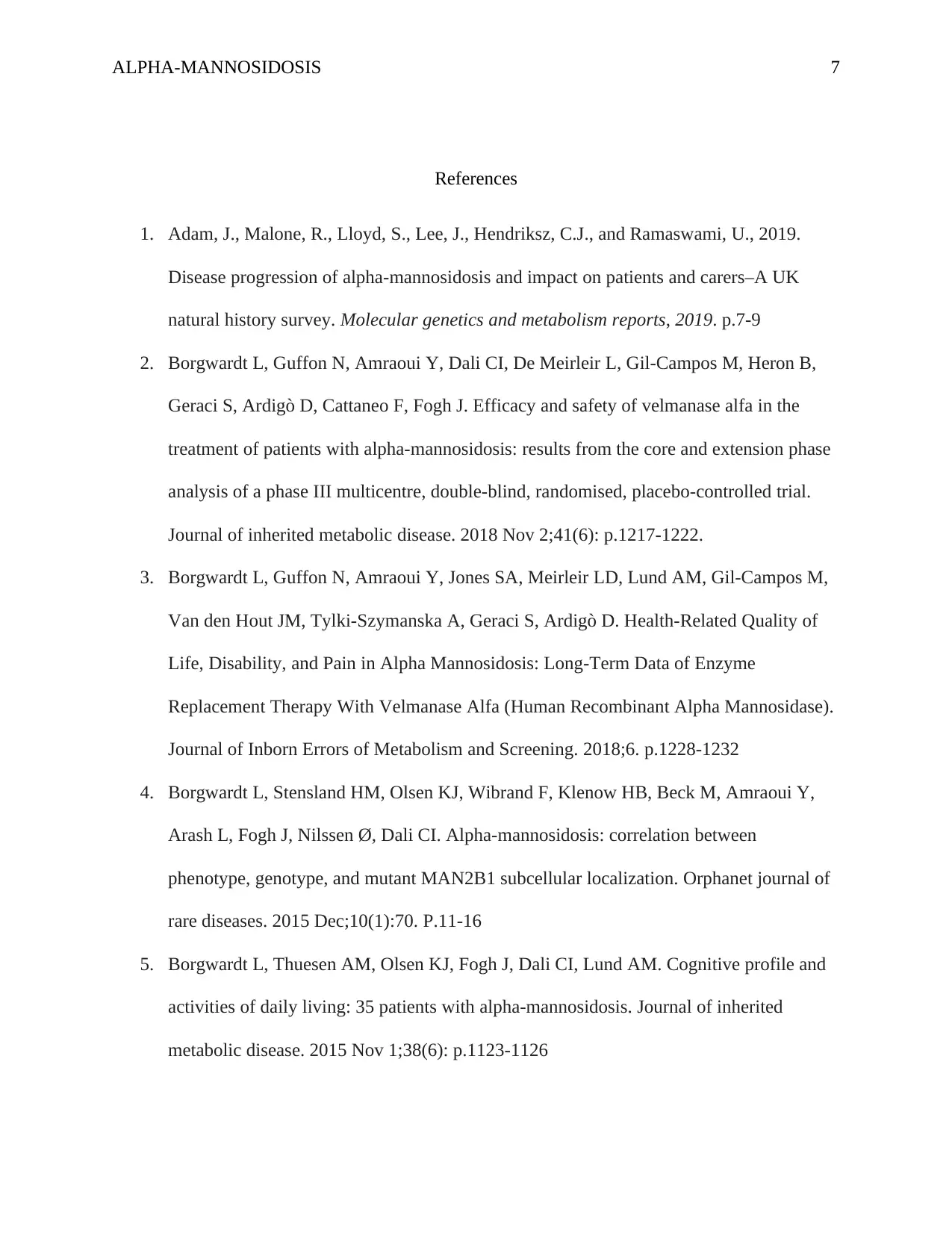
ALPHA-MANNOSIDOSIS 7
References
1. Adam, J., Malone, R., Lloyd, S., Lee, J., Hendriksz, C.J., and Ramaswami, U., 2019.
Disease progression of alpha-mannosidosis and impact on patients and carers–A UK
natural history survey. Molecular genetics and metabolism reports, 2019. p.7-9
2. Borgwardt L, Guffon N, Amraoui Y, Dali CI, De Meirleir L, Gil-Campos M, Heron B,
Geraci S, Ardigò D, Cattaneo F, Fogh J. Efficacy and safety of velmanase alfa in the
treatment of patients with alpha-mannosidosis: results from the core and extension phase
analysis of a phase III multicentre, double-blind, randomised, placebo-controlled trial.
Journal of inherited metabolic disease. 2018 Nov 2;41(6): p.1217-1222.
3. Borgwardt L, Guffon N, Amraoui Y, Jones SA, Meirleir LD, Lund AM, Gil-Campos M,
Van den Hout JM, Tylki-Szymanska A, Geraci S, Ardigò D. Health-Related Quality of
Life, Disability, and Pain in Alpha Mannosidosis: Long-Term Data of Enzyme
Replacement Therapy With Velmanase Alfa (Human Recombinant Alpha Mannosidase).
Journal of Inborn Errors of Metabolism and Screening. 2018;6. p.1228-1232
4. Borgwardt L, Stensland HM, Olsen KJ, Wibrand F, Klenow HB, Beck M, Amraoui Y,
Arash L, Fogh J, Nilssen Ø, Dali CI. Alpha-mannosidosis: correlation between
phenotype, genotype, and mutant MAN2B1 subcellular localization. Orphanet journal of
rare diseases. 2015 Dec;10(1):70. P.11-16
5. Borgwardt L, Thuesen AM, Olsen KJ, Fogh J, Dali CI, Lund AM. Cognitive profile and
activities of daily living: 35 patients with alpha-mannosidosis. Journal of inherited
metabolic disease. 2015 Nov 1;38(6): p.1123-1126
References
1. Adam, J., Malone, R., Lloyd, S., Lee, J., Hendriksz, C.J., and Ramaswami, U., 2019.
Disease progression of alpha-mannosidosis and impact on patients and carers–A UK
natural history survey. Molecular genetics and metabolism reports, 2019. p.7-9
2. Borgwardt L, Guffon N, Amraoui Y, Dali CI, De Meirleir L, Gil-Campos M, Heron B,
Geraci S, Ardigò D, Cattaneo F, Fogh J. Efficacy and safety of velmanase alfa in the
treatment of patients with alpha-mannosidosis: results from the core and extension phase
analysis of a phase III multicentre, double-blind, randomised, placebo-controlled trial.
Journal of inherited metabolic disease. 2018 Nov 2;41(6): p.1217-1222.
3. Borgwardt L, Guffon N, Amraoui Y, Jones SA, Meirleir LD, Lund AM, Gil-Campos M,
Van den Hout JM, Tylki-Szymanska A, Geraci S, Ardigò D. Health-Related Quality of
Life, Disability, and Pain in Alpha Mannosidosis: Long-Term Data of Enzyme
Replacement Therapy With Velmanase Alfa (Human Recombinant Alpha Mannosidase).
Journal of Inborn Errors of Metabolism and Screening. 2018;6. p.1228-1232
4. Borgwardt L, Stensland HM, Olsen KJ, Wibrand F, Klenow HB, Beck M, Amraoui Y,
Arash L, Fogh J, Nilssen Ø, Dali CI. Alpha-mannosidosis: correlation between
phenotype, genotype, and mutant MAN2B1 subcellular localization. Orphanet journal of
rare diseases. 2015 Dec;10(1):70. P.11-16
5. Borgwardt L, Thuesen AM, Olsen KJ, Fogh J, Dali CI, Lund AM. Cognitive profile and
activities of daily living: 35 patients with alpha-mannosidosis. Journal of inherited
metabolic disease. 2015 Nov 1;38(6): p.1123-1126
Paraphrase This Document
Need a fresh take? Get an instant paraphrase of this document with our AI Paraphraser
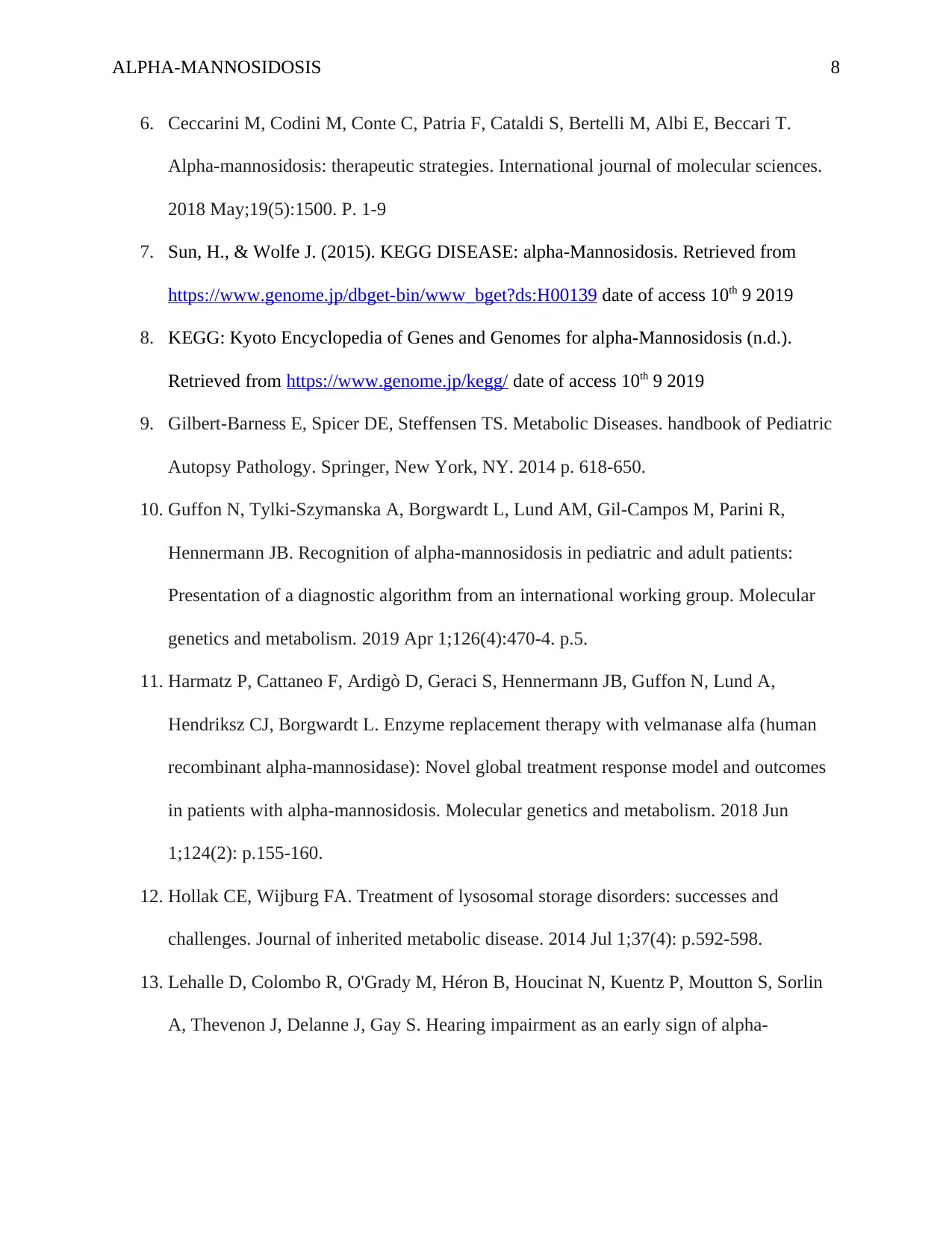
ALPHA-MANNOSIDOSIS 8
6. Ceccarini M, Codini M, Conte C, Patria F, Cataldi S, Bertelli M, Albi E, Beccari T.
Alpha-mannosidosis: therapeutic strategies. International journal of molecular sciences.
2018 May;19(5):1500. P. 1-9
7. Sun, H., & Wolfe J. (2015). KEGG DISEASE: alpha-Mannosidosis. Retrieved from
https://www.genome.jp/dbget-bin/www_bget?ds:H00139 date of access 10th 9 2019
8. KEGG: Kyoto Encyclopedia of Genes and Genomes for alpha-Mannosidosis (n.d.).
Retrieved from https://www.genome.jp/kegg/ date of access 10th 9 2019
9. Gilbert-Barness E, Spicer DE, Steffensen TS. Metabolic Diseases. handbook of Pediatric
Autopsy Pathology. Springer, New York, NY. 2014 p. 618-650.
10. Guffon N, Tylki-Szymanska A, Borgwardt L, Lund AM, Gil-Campos M, Parini R,
Hennermann JB. Recognition of alpha-mannosidosis in pediatric and adult patients:
Presentation of a diagnostic algorithm from an international working group. Molecular
genetics and metabolism. 2019 Apr 1;126(4):470-4. p.5.
11. Harmatz P, Cattaneo F, Ardigò D, Geraci S, Hennermann JB, Guffon N, Lund A,
Hendriksz CJ, Borgwardt L. Enzyme replacement therapy with velmanase alfa (human
recombinant alpha-mannosidase): Novel global treatment response model and outcomes
in patients with alpha-mannosidosis. Molecular genetics and metabolism. 2018 Jun
1;124(2): p.155-160.
12. Hollak CE, Wijburg FA. Treatment of lysosomal storage disorders: successes and
challenges. Journal of inherited metabolic disease. 2014 Jul 1;37(4): p.592-598.
13. Lehalle D, Colombo R, O'Grady M, Héron B, Houcinat N, Kuentz P, Moutton S, Sorlin
A, Thevenon J, Delanne J, Gay S. Hearing impairment as an early sign of alpha‐
6. Ceccarini M, Codini M, Conte C, Patria F, Cataldi S, Bertelli M, Albi E, Beccari T.
Alpha-mannosidosis: therapeutic strategies. International journal of molecular sciences.
2018 May;19(5):1500. P. 1-9
7. Sun, H., & Wolfe J. (2015). KEGG DISEASE: alpha-Mannosidosis. Retrieved from
https://www.genome.jp/dbget-bin/www_bget?ds:H00139 date of access 10th 9 2019
8. KEGG: Kyoto Encyclopedia of Genes and Genomes for alpha-Mannosidosis (n.d.).
Retrieved from https://www.genome.jp/kegg/ date of access 10th 9 2019
9. Gilbert-Barness E, Spicer DE, Steffensen TS. Metabolic Diseases. handbook of Pediatric
Autopsy Pathology. Springer, New York, NY. 2014 p. 618-650.
10. Guffon N, Tylki-Szymanska A, Borgwardt L, Lund AM, Gil-Campos M, Parini R,
Hennermann JB. Recognition of alpha-mannosidosis in pediatric and adult patients:
Presentation of a diagnostic algorithm from an international working group. Molecular
genetics and metabolism. 2019 Apr 1;126(4):470-4. p.5.
11. Harmatz P, Cattaneo F, Ardigò D, Geraci S, Hennermann JB, Guffon N, Lund A,
Hendriksz CJ, Borgwardt L. Enzyme replacement therapy with velmanase alfa (human
recombinant alpha-mannosidase): Novel global treatment response model and outcomes
in patients with alpha-mannosidosis. Molecular genetics and metabolism. 2018 Jun
1;124(2): p.155-160.
12. Hollak CE, Wijburg FA. Treatment of lysosomal storage disorders: successes and
challenges. Journal of inherited metabolic disease. 2014 Jul 1;37(4): p.592-598.
13. Lehalle D, Colombo R, O'Grady M, Héron B, Houcinat N, Kuentz P, Moutton S, Sorlin
A, Thevenon J, Delanne J, Gay S. Hearing impairment as an early sign of alpha‐
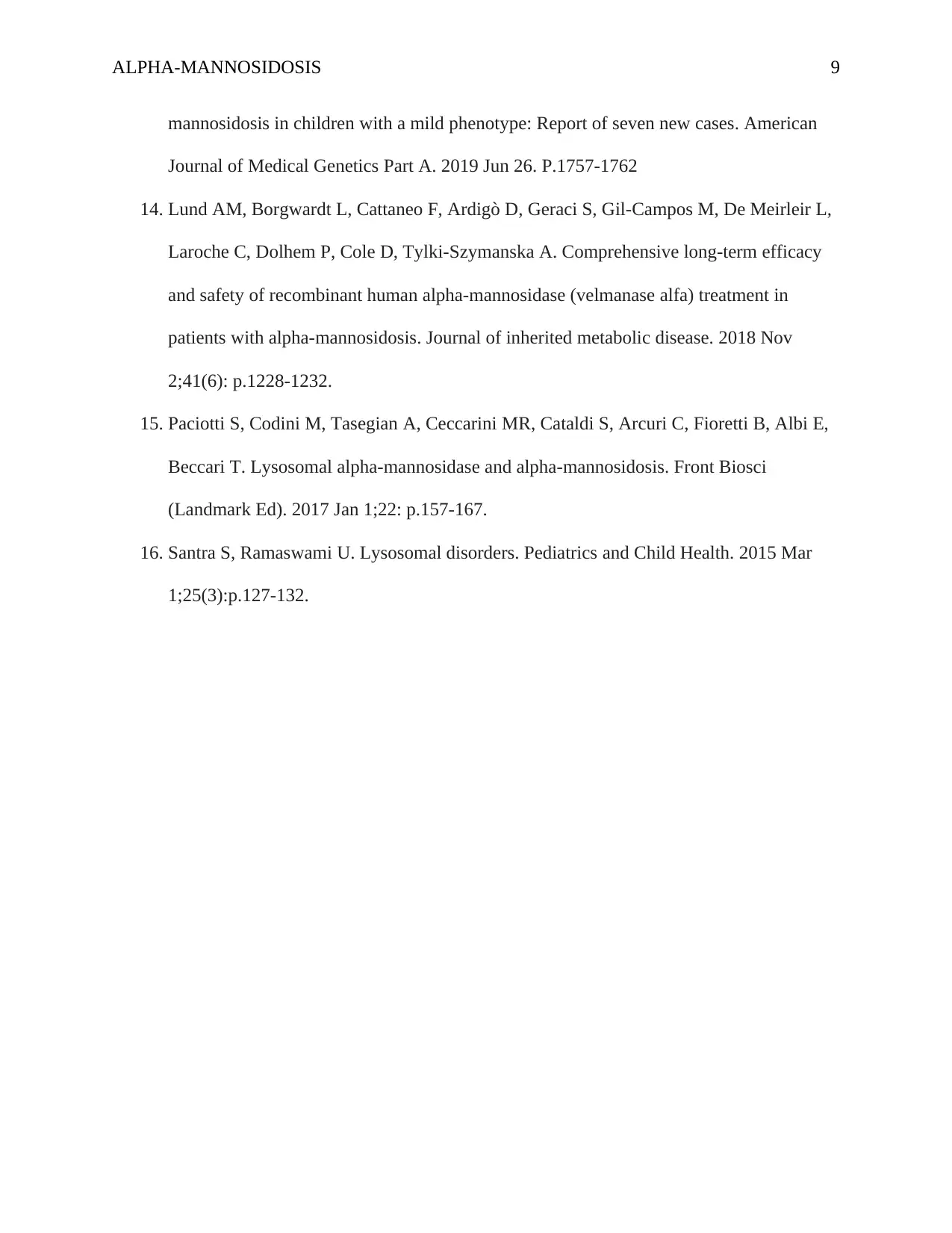
ALPHA-MANNOSIDOSIS 9
mannosidosis in children with a mild phenotype: Report of seven new cases. American
Journal of Medical Genetics Part A. 2019 Jun 26. P.1757-1762
14. Lund AM, Borgwardt L, Cattaneo F, Ardigò D, Geraci S, Gil-Campos M, De Meirleir L,
Laroche C, Dolhem P, Cole D, Tylki-Szymanska A. Comprehensive long-term efficacy
and safety of recombinant human alpha-mannosidase (velmanase alfa) treatment in
patients with alpha-mannosidosis. Journal of inherited metabolic disease. 2018 Nov
2;41(6): p.1228-1232.
15. Paciotti S, Codini M, Tasegian A, Ceccarini MR, Cataldi S, Arcuri C, Fioretti B, Albi E,
Beccari T. Lysosomal alpha-mannosidase and alpha-mannosidosis. Front Biosci
(Landmark Ed). 2017 Jan 1;22: p.157-167.
16. Santra S, Ramaswami U. Lysosomal disorders. Pediatrics and Child Health. 2015 Mar
1;25(3):p.127-132.
mannosidosis in children with a mild phenotype: Report of seven new cases. American
Journal of Medical Genetics Part A. 2019 Jun 26. P.1757-1762
14. Lund AM, Borgwardt L, Cattaneo F, Ardigò D, Geraci S, Gil-Campos M, De Meirleir L,
Laroche C, Dolhem P, Cole D, Tylki-Szymanska A. Comprehensive long-term efficacy
and safety of recombinant human alpha-mannosidase (velmanase alfa) treatment in
patients with alpha-mannosidosis. Journal of inherited metabolic disease. 2018 Nov
2;41(6): p.1228-1232.
15. Paciotti S, Codini M, Tasegian A, Ceccarini MR, Cataldi S, Arcuri C, Fioretti B, Albi E,
Beccari T. Lysosomal alpha-mannosidase and alpha-mannosidosis. Front Biosci
(Landmark Ed). 2017 Jan 1;22: p.157-167.
16. Santra S, Ramaswami U. Lysosomal disorders. Pediatrics and Child Health. 2015 Mar
1;25(3):p.127-132.
⊘ This is a preview!⊘
Do you want full access?
Subscribe today to unlock all pages.

Trusted by 1+ million students worldwide
1 out of 9
Related Documents
Your All-in-One AI-Powered Toolkit for Academic Success.
+13062052269
info@desklib.com
Available 24*7 on WhatsApp / Email
![[object Object]](/_next/static/media/star-bottom.7253800d.svg)
Unlock your academic potential
Copyright © 2020–2025 A2Z Services. All Rights Reserved. Developed and managed by ZUCOL.





